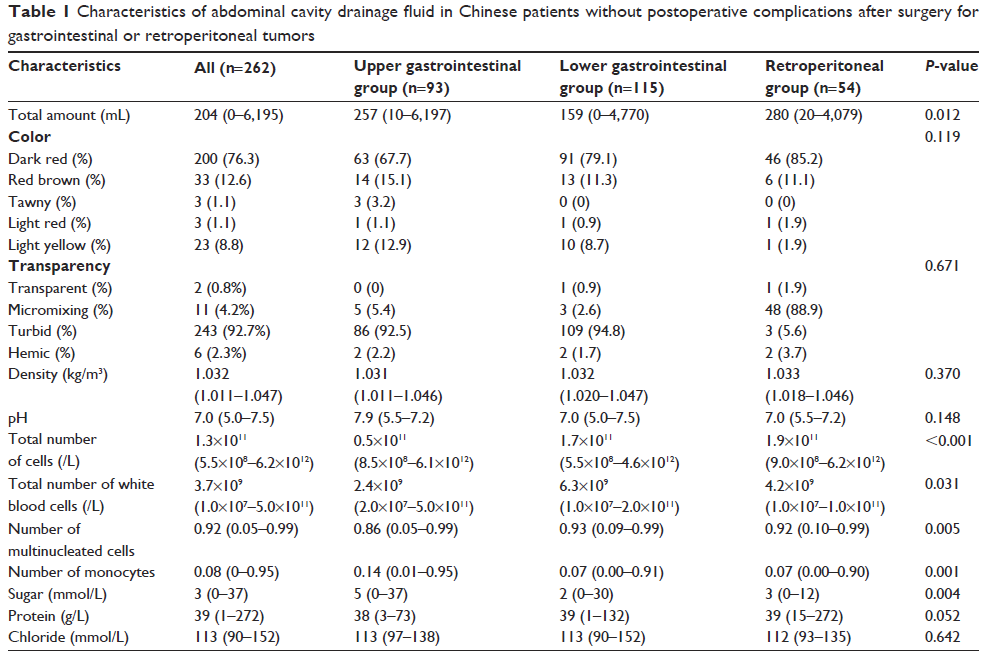108605
论文已发表
注册即可获取德孚的最新动态
IF 收录期刊
- 3.4 Breast Cancer (Dove Med Press)
- 3.2 Clin Epidemiol
- 2.6 Cancer Manag Res
- 2.9 Infect Drug Resist
- 3.7 Clin Interv Aging
- 5.1 Drug Des Dev Ther
- 3.1 Int J Chronic Obstr
- 6.6 Int J Nanomed
- 2.6 Int J Women's Health
- 2.9 Neuropsych Dis Treat
- 2.8 OncoTargets Ther
- 2.0 Patient Prefer Adher
- 2.2 Ther Clin Risk Manag
- 2.5 J Pain Res
- 3.0 Diabet Metab Synd Ob
- 3.2 Psychol Res Behav Ma
- 3.4 Nat Sci Sleep
- 1.8 Pharmgenomics Pers Med
- 2.0 Risk Manag Healthc Policy
- 4.1 J Inflamm Res
- 2.0 Int J Gen Med
- 3.4 J Hepatocell Carcinoma
- 3.0 J Asthma Allergy
- 2.2 Clin Cosmet Investig Dermatol
- 2.4 J Multidiscip Healthc

接受胃肠道或腹膜后肿瘤手术后无术后并发症的中国病患的腹腔引流液的特点
Authors Zhou J, Pi H, Zheng Y
Published Date January 2015 Volume 2015:10 Pages 367—370
DOI http://dx.doi.org/10.2147/CIA.S76512
Received 28 October 2014, Accepted 3 December 2014, Published 28 January 2015
Background: Abdominal cavity drainage fluid can be used
as an early diagnostic tool of postoperative complications, and observing its
characteristics can help us to judge and handle postoperative complications.
There is no accurate standard reference range on its characteristics after
surgeries for gastrointestinal or retroperitoneal tumors. This research
attempted to analyze its characteristics in Chinese patients without
postoperative complications after surgery for gastrointestinal or
retroperitoneal tumors, and to offer an experimental basis for establishing a
reliable standard reference range for abdominal cavity drainage fluid used to
detect postoperative complications.
Methods: This study enrolled
262 Chinese patients without postoperative complications after surgery for
gastrointestinal or retroperitoneal tumors.
Results: All patients had a
median age (range) of 55 (19–72) years, and 150 (57.3%) were men. There were 93
(35.5%), 115 (43.9%), and 54 (20.6%) patients who underwent surgery for upper
gastrointestinal tumors, lower gastrointestinal tumors, and retroperitoneal
tumors, respectively. The total amount, density, and pH of the abdominal cavity
drainage fluid were 204 (0–6,195) mL, 1.032 (1.011–1.047) kg/m3,
and pH 7.0 (5.0–7.5), respectively. The total numbers of cells and white blood
cells were 1.3×1011 (5.5×108–6.2×1012)/L and
3.7×109 (1.0×107–5.0×1011)/L, respectively.
The levels of sugar and protein were 3 (0–37) mmol/L and 39 (1–272) g/L. The
total amount of abdominal cavity drainage fluid, the total number of cells, the
total number of white blood cells, the number of multinucleated cells, the
number of monocytes, and the levels of sugar were statistically significantly
different between the three groups (P <0.05 for
all).
Conclusion: This study
described the characteristics of abdominal cavity drainage fluid in Chinese
patients without postoperative complications after surgery for gastrointestinal
or retroperitoneal tumors, and provided an experimental basis for establishing
a reliable standard reference range for abdominal cavity drainage fluid for
screening for postoperative complications.
Keywords: abdominal cavity
drainage fluid, People’s Republic of China, gastrointestinal tumors,
postoperative complications, retroperitoneal tumors
